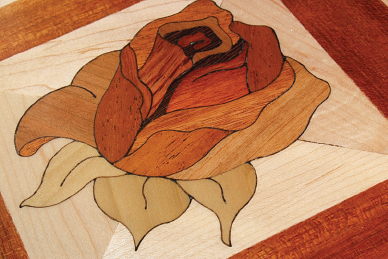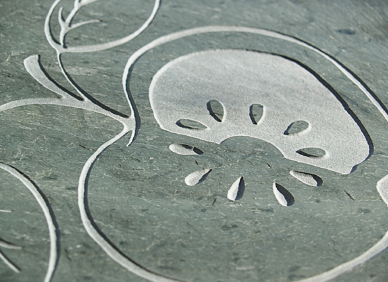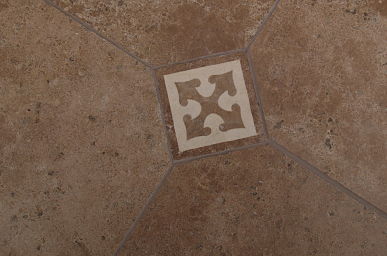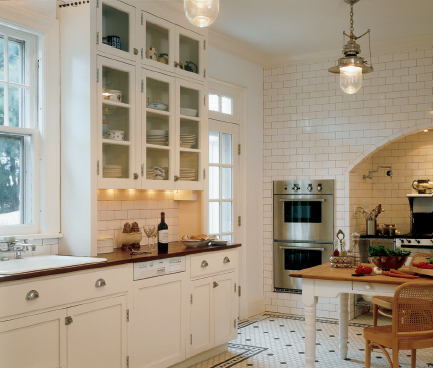
Floors are rarely the focal point of a room. However, this need not be the case. Flooring can steal the show. One way is to design your own custom floor. Many flooring materials lend themselves to customization. Another approach is to enhance an otherwise plain floor with decorative accents, such as medallions and borders. You can design your own or buy them ready-made. Painted designs on floor cloths, carpet, or wood can also grab attention. Even concrete and stone flooring can be etched or sandblasted with the textures, patterns, or images you desire.

This painted compass, looks like an inlay of marble, wood, and metal. The artist muted the wood grain and coloring of the surrounding floor to heighten the contrast.

This detail shows an elaborate border, based upon a classic pattern popular in the Victorian era. Composed of pieces of veneer glued to solid tongue-and-groove planks, it is available by the foot.

For a more contemporary feeling, a border is fashioned by alternating light and dark segments of solid-wood planking.

Ready-made borders, are available for vinyl flooring that’s made to look like wood.

Borders, can also be very simple. In this sunroom, two tones of wood plank are used to create a subtle border.
Borders are another way to bring attention to your floors. They work in much the same way as a frame around a picture. Use them with just about any kind of flooring, including wood, stone, ceramic, vinyl, cork, and linoleum. Opt for ready-made patterns that range from floral to geometric designs, or compose your own. Border modules include straight sections and 90-degree turns for corners. Wood borders are available prefinished or unfinished, so you can match the stain and finish to your site-finished floor. When selecting borders, keep scale in mind. A wide, elaborate border may overpower a small room. If you are going to fill the room with furniture, you may be wise to skip the borders because you won’t see much of them and they are costly — $10 to $70 per lineal foot (before installation), depending on design complexity. Save them for a large space or entry.
Medallions make dramatic focal points, best suited to large floor areas where they can be seen. They are typically round or oval, but they’re also available in octagonals, stars, and squares. They are created from exotic woods, marble, granite, limestone, onyx, and ceramics. Brass or aluminum inlay can be used to set off the shapes. Sizes usually range from 2 to 6 feet in diameter.
Wood medallions can be set into either solid or engineered wood floors. Computerized cutting machines make a wide variety of designs possible. Even small wood medallions can cost over $1,000. Check with the manufacturer about how the medallion finish will wear in traffic before you install one in your foyer.
Stone medallions are best suited to stone and ceramic floors. They typically come preassembled on mesh backings, allowing the joints to be grouted on site. Water jet technology, where water and an abrasive are shot through small nozzles at high pressure to create the desired cuts, have made such works of art more economically feasible — but they are still expensive. A 30-inch-diameter marble-and-granite medallion, for example, can easily cost $2,000. Labor to install it will add to the cost. Medallions can be created with other materials as well, including ceramic and glass tile or linoleum.
Decorative accents are a more subtle way to bring attention to your floors. They are smaller, often only a few inches square, and usually used in repetitive patterns. Otherwise, they are made using the same methods as medallions.

Most stone medallions are custom-made — not stock items — so homeowners can select materials that coordinate with their floor, left.

Variations, on compass and rose motifs are popular for medallions in both stone and wood.

This wood medallion, was site-finished to match the finish on the rest of the room's flooring.

Decorative wood accents, are available in stock patterns, including this rose motif.

Decorative accents, such as this one, are fabricated using water-jet technology.

Etched slate tiles, are available in a variety of patterns and sizes. Custom designs are also an option.
Mosaic floors are composed of small pieces of colored stone, glass, tile, and other materials. They may be used to create interesting textures, patterns, or pictures. An ancient craft first popularized by the Greeks using pebbles and later by Romans using small tiles, mosaic floors often have a classical look. They can, however, be used in traditional, eclectic, and contemporary decorating schemes as well. Mosaics can be used to create borders, inlay strips (between larger field tiles), inserts (to replace larger tiles), and medallions. Pictorial subjects may include historical reproductions and a vast array of floral, animal, and celestial motifs. Mosaic tiles are sold individually or in preassembled motifs; set them with either mortar or adhesive. Some manufacturers allow you to design your own pattern, tile by tile. Then they ship it to you preassembled on a mesh backing or held together with a paper top sheet.

Versatile ceramic mosaics, can be used to create free-form patterns, as in this contemporary bath.

Patterns, can be generated with computer design software and then preassembled in sections for easier installation.

The mosaics in this shower, opposite, have a baked-on finish that makes them resistant to lime deposits, dirt, and mold.

Pictorial mosaics, make interesting decorative accents in floors, especially when they are placed along a border.

Translucent glass mosaics sparkle against the opaque matte-finished field tiles in this foyer floor, left.

Traditional white hexagonal mosaics, with borders and accents, evoke the turn of the last century in this kitchen.

Inexpensive accents in stone and ceramic,x transform a plain tile floor.